What a difference two years can make. Tanzania and seasonal change.
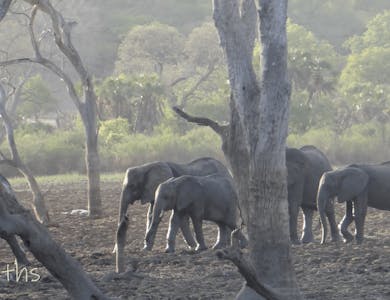
Guest blog
All this fantastic British weather we have had this year had me thinking about our trip to Tanzania in 2017.
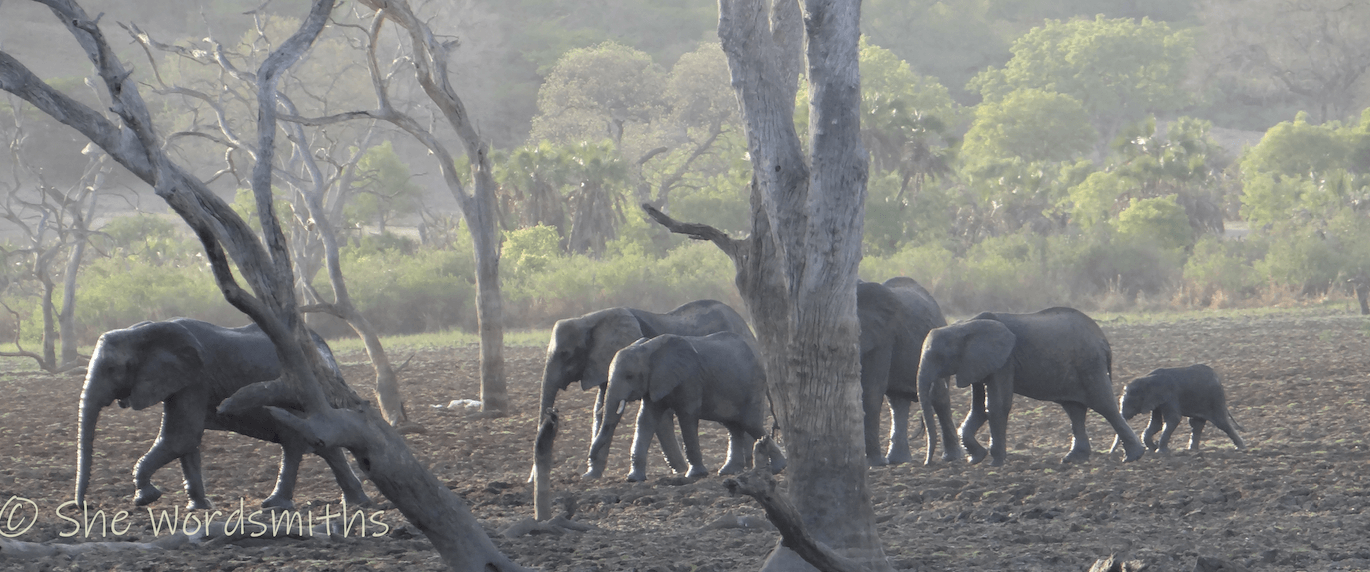 We had had a safari holiday, within the Selous Game Reserve, a couple of years before and truly fallen in love with the place. Selous is one of the largest reserves in the world, larger than Switzerland in fact. While a large part of the reserve is still active in game hunting this is now mainly south of the Rufiji River. The north side of the Rufiji has a large area turned over to conservation and a designated photography zone. Safaris can be taken on foot, by boat and by vehicle. It was this variety in safari styles which attracted us there the first time around.
So when a special birthday meant a special holiday we found ourselves yearning to return. This time, we chose two camps, in two very different reserves. The first Kigelia, a small tented camp in the Ruaha National Park. The second, the lovely Sand Rivers in the Selous Game Reserve, which stole our hearts the first time around.
We had had a safari holiday, within the Selous Game Reserve, a couple of years before and truly fallen in love with the place. Selous is one of the largest reserves in the world, larger than Switzerland in fact. While a large part of the reserve is still active in game hunting this is now mainly south of the Rufiji River. The north side of the Rufiji has a large area turned over to conservation and a designated photography zone. Safaris can be taken on foot, by boat and by vehicle. It was this variety in safari styles which attracted us there the first time around.
So when a special birthday meant a special holiday we found ourselves yearning to return. This time, we chose two camps, in two very different reserves. The first Kigelia, a small tented camp in the Ruaha National Park. The second, the lovely Sand Rivers in the Selous Game Reserve, which stole our hearts the first time around.
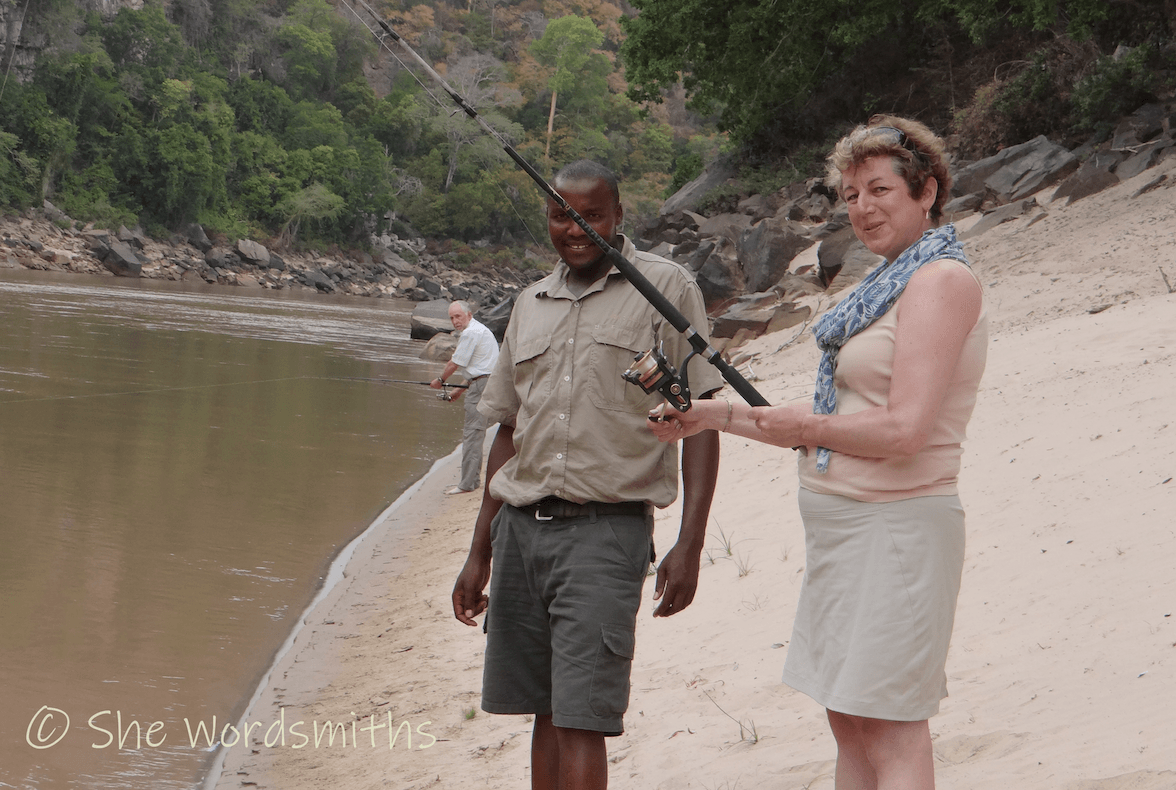 The first time we visited Tanzania it was a February. It followed a heavy period of rain so the vegetation was green and healthy. I remember remarking it was not unlike Scotland in its geography – only 30 degrees warmer! By contrast our trip this time, in January, would find the country in desperate need of rain. November and December is known as the short rain season. A respite follows before the big rains arrive in March until June. So generally in January/February the rivers are beginning to refill after the dry summer and the lakes are holding water. Not this year. The area had reported just one day of significant rain since October. The Great Ruaha River is already seasonal due to irrigation of the rice fields in the upper reaches. But with the dry season effectively extended, the consequences were vividly apparent.
The real sadness, though, is that the lack of water leads to lack of vegetation for the herbivores. And none more apparent than in Selous. As we flew in, the difference in the landscape was quite a shock. I mean, this is what you might expect in August surely? Not in January. We heard farmers were struggling too with cattle dying daily in the northern areas of Tanzania. Buffalo, normally a solid beefy animal, were painfully thin and weak. An easy target for predators. Our first game drive out would reveal two carcasses - one a lion kill, the second a natural death which would go on to provide some food for this pride for a couple of days more. Two days later and word spread there were two more down, same location. None with nearly enough meat to satisfy a pride of four adult lionesses, six tiny cubs and the male lion who would come in to take control of the table and take his fill before allowing the rest to feed.
The first time we visited Tanzania it was a February. It followed a heavy period of rain so the vegetation was green and healthy. I remember remarking it was not unlike Scotland in its geography – only 30 degrees warmer! By contrast our trip this time, in January, would find the country in desperate need of rain. November and December is known as the short rain season. A respite follows before the big rains arrive in March until June. So generally in January/February the rivers are beginning to refill after the dry summer and the lakes are holding water. Not this year. The area had reported just one day of significant rain since October. The Great Ruaha River is already seasonal due to irrigation of the rice fields in the upper reaches. But with the dry season effectively extended, the consequences were vividly apparent.
The real sadness, though, is that the lack of water leads to lack of vegetation for the herbivores. And none more apparent than in Selous. As we flew in, the difference in the landscape was quite a shock. I mean, this is what you might expect in August surely? Not in January. We heard farmers were struggling too with cattle dying daily in the northern areas of Tanzania. Buffalo, normally a solid beefy animal, were painfully thin and weak. An easy target for predators. Our first game drive out would reveal two carcasses - one a lion kill, the second a natural death which would go on to provide some food for this pride for a couple of days more. Two days later and word spread there were two more down, same location. None with nearly enough meat to satisfy a pride of four adult lionesses, six tiny cubs and the male lion who would come in to take control of the table and take his fill before allowing the rest to feed.
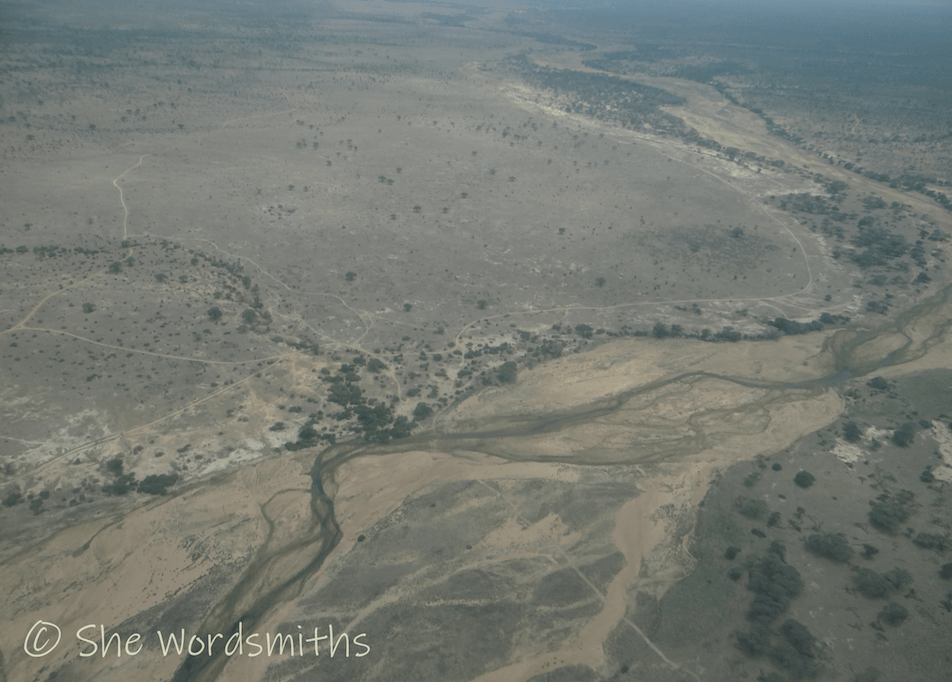
 We had had a safari holiday, within the Selous Game Reserve, a couple of years before and truly fallen in love with the place. Selous is one of the largest reserves in the world, larger than Switzerland in fact. While a large part of the reserve is still active in game hunting this is now mainly south of the Rufiji River. The north side of the Rufiji has a large area turned over to conservation and a designated photography zone. Safaris can be taken on foot, by boat and by vehicle. It was this variety in safari styles which attracted us there the first time around.
So when a special birthday meant a special holiday we found ourselves yearning to return. This time, we chose two camps, in two very different reserves. The first Kigelia, a small tented camp in the Ruaha National Park. The second, the lovely Sand Rivers in the Selous Game Reserve, which stole our hearts the first time around.
We had had a safari holiday, within the Selous Game Reserve, a couple of years before and truly fallen in love with the place. Selous is one of the largest reserves in the world, larger than Switzerland in fact. While a large part of the reserve is still active in game hunting this is now mainly south of the Rufiji River. The north side of the Rufiji has a large area turned over to conservation and a designated photography zone. Safaris can be taken on foot, by boat and by vehicle. It was this variety in safari styles which attracted us there the first time around.
So when a special birthday meant a special holiday we found ourselves yearning to return. This time, we chose two camps, in two very different reserves. The first Kigelia, a small tented camp in the Ruaha National Park. The second, the lovely Sand Rivers in the Selous Game Reserve, which stole our hearts the first time around.
 The first time we visited Tanzania it was a February. It followed a heavy period of rain so the vegetation was green and healthy. I remember remarking it was not unlike Scotland in its geography – only 30 degrees warmer! By contrast our trip this time, in January, would find the country in desperate need of rain. November and December is known as the short rain season. A respite follows before the big rains arrive in March until June. So generally in January/February the rivers are beginning to refill after the dry summer and the lakes are holding water. Not this year. The area had reported just one day of significant rain since October. The Great Ruaha River is already seasonal due to irrigation of the rice fields in the upper reaches. But with the dry season effectively extended, the consequences were vividly apparent.
The real sadness, though, is that the lack of water leads to lack of vegetation for the herbivores. And none more apparent than in Selous. As we flew in, the difference in the landscape was quite a shock. I mean, this is what you might expect in August surely? Not in January. We heard farmers were struggling too with cattle dying daily in the northern areas of Tanzania. Buffalo, normally a solid beefy animal, were painfully thin and weak. An easy target for predators. Our first game drive out would reveal two carcasses - one a lion kill, the second a natural death which would go on to provide some food for this pride for a couple of days more. Two days later and word spread there were two more down, same location. None with nearly enough meat to satisfy a pride of four adult lionesses, six tiny cubs and the male lion who would come in to take control of the table and take his fill before allowing the rest to feed.
The first time we visited Tanzania it was a February. It followed a heavy period of rain so the vegetation was green and healthy. I remember remarking it was not unlike Scotland in its geography – only 30 degrees warmer! By contrast our trip this time, in January, would find the country in desperate need of rain. November and December is known as the short rain season. A respite follows before the big rains arrive in March until June. So generally in January/February the rivers are beginning to refill after the dry summer and the lakes are holding water. Not this year. The area had reported just one day of significant rain since October. The Great Ruaha River is already seasonal due to irrigation of the rice fields in the upper reaches. But with the dry season effectively extended, the consequences were vividly apparent.
The real sadness, though, is that the lack of water leads to lack of vegetation for the herbivores. And none more apparent than in Selous. As we flew in, the difference in the landscape was quite a shock. I mean, this is what you might expect in August surely? Not in January. We heard farmers were struggling too with cattle dying daily in the northern areas of Tanzania. Buffalo, normally a solid beefy animal, were painfully thin and weak. An easy target for predators. Our first game drive out would reveal two carcasses - one a lion kill, the second a natural death which would go on to provide some food for this pride for a couple of days more. Two days later and word spread there were two more down, same location. None with nearly enough meat to satisfy a pride of four adult lionesses, six tiny cubs and the male lion who would come in to take control of the table and take his fill before allowing the rest to feed.

All this took place in an area we didn't recognise as having once been the well- stocked lake where we spent many a morning breakfast at our previous visit. Now it looked like a dry ploughed field. Two buffalo had taken to submerging themselves in a mud hole on a daily basis, too weak to find a new area to feed. They were existing on very little, it would seem, their only pleasure a daily dunk in a cooling mud pool.
The plus side is, when you do discover water, you can be sure to find game. But you couldn’t help but feel for the wildlife, too weak to move to find better vegetation, their fate, at the hands of predators, almost inevitable.
Meanwhile, in Ruaha, the lack of rain treated us to some really special moments. Elephants are pretty resourceful when it comes to finding water. Take a dig in an apparently dry river bed and "bingo!" A water well. We sat for a while watching a family head to the river and teach their young how to find water. One "Tembo" was so small he or she would have to get down on its elbows to reach the bottom with its trunk.
Midway through our first week we did have a short shower. Barely a few drops, yet somehow it had made a wee puddle in the track. You had to be there to see this elephant group literally run to the water. Adults first, followed by these little legs. "Wait for me". How many little Tembo can you fit in a puddle? All the young dived in, squirmed and wriggled and made the most amazing blissful sounds. The parents stood over them taking a little to spray themselves. "It's fine kids, you bath, I'll make do with a wash". Within minutes it was over. They scrambled out and carried on into the trees. A chance in a million. Right place right time.
 Two more days and we were finally treated to some heavy overnight rain. We should have guessed we were in for a storm when we discovered two carefully placed pairs of wellies and two umbrellas in our tent. That night we had a super thunderstorm. And even just that short time made a difference to the roads, with the track into camp becoming impassable. Good news for the vegetation of course, but the downside is that the animals don't like storms and so move out. The following morning, we would spend hours scouring an area frequented by cheetah without success. Not surprising as there was barely any plains game. Though we did photograph lots of birds.
Two more days and we were finally treated to some heavy overnight rain. We should have guessed we were in for a storm when we discovered two carefully placed pairs of wellies and two umbrellas in our tent. That night we had a super thunderstorm. And even just that short time made a difference to the roads, with the track into camp becoming impassable. Good news for the vegetation of course, but the downside is that the animals don't like storms and so move out. The following morning, we would spend hours scouring an area frequented by cheetah without success. Not surprising as there was barely any plains game. Though we did photograph lots of birds.
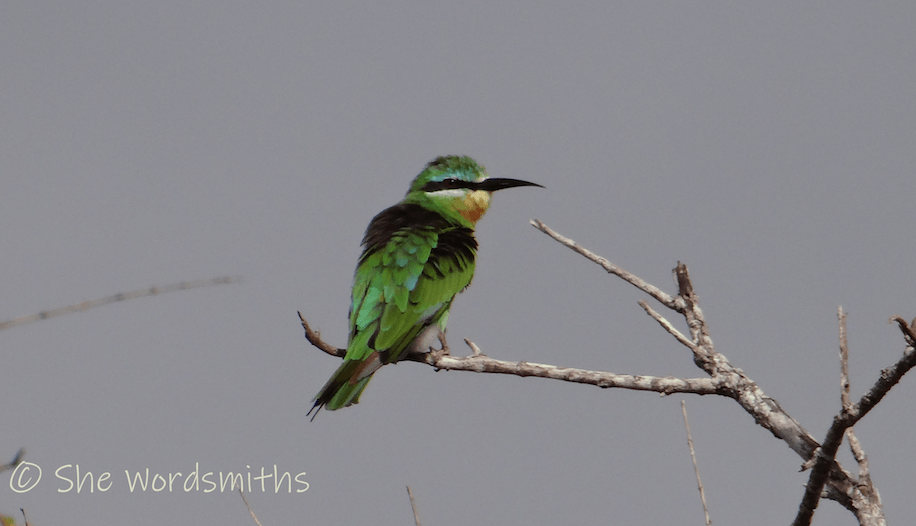 But the ultimate memory has to be the bull elephant. We rounded a corner to discover three boys grazing. Then one of them spotted a little water hole. We stopped to watch as he made his way towards the water - and to us. You can't help but hold your breath. Not daring to speak. And there he stands up to his ankles in water and mud and begins his all over wash. How we escaped being splattered I will never know - because he was no more than maybe five metres away.
But the ultimate memory has to be the bull elephant. We rounded a corner to discover three boys grazing. Then one of them spotted a little water hole. We stopped to watch as he made his way towards the water - and to us. You can't help but hold your breath. Not daring to speak. And there he stands up to his ankles in water and mud and begins his all over wash. How we escaped being splattered I will never know - because he was no more than maybe five metres away.
 Two more days and we were finally treated to some heavy overnight rain. We should have guessed we were in for a storm when we discovered two carefully placed pairs of wellies and two umbrellas in our tent. That night we had a super thunderstorm. And even just that short time made a difference to the roads, with the track into camp becoming impassable. Good news for the vegetation of course, but the downside is that the animals don't like storms and so move out. The following morning, we would spend hours scouring an area frequented by cheetah without success. Not surprising as there was barely any plains game. Though we did photograph lots of birds.
Two more days and we were finally treated to some heavy overnight rain. We should have guessed we were in for a storm when we discovered two carefully placed pairs of wellies and two umbrellas in our tent. That night we had a super thunderstorm. And even just that short time made a difference to the roads, with the track into camp becoming impassable. Good news for the vegetation of course, but the downside is that the animals don't like storms and so move out. The following morning, we would spend hours scouring an area frequented by cheetah without success. Not surprising as there was barely any plains game. Though we did photograph lots of birds.
 But the ultimate memory has to be the bull elephant. We rounded a corner to discover three boys grazing. Then one of them spotted a little water hole. We stopped to watch as he made his way towards the water - and to us. You can't help but hold your breath. Not daring to speak. And there he stands up to his ankles in water and mud and begins his all over wash. How we escaped being splattered I will never know - because he was no more than maybe five metres away.
But the ultimate memory has to be the bull elephant. We rounded a corner to discover three boys grazing. Then one of them spotted a little water hole. We stopped to watch as he made his way towards the water - and to us. You can't help but hold your breath. Not daring to speak. And there he stands up to his ankles in water and mud and begins his all over wash. How we escaped being splattered I will never know - because he was no more than maybe five metres away.
And then you could almost see his mind working as he bent down. Is it big enough? Could I maybe get in? And then, gently, he lowered himself down. Front legs first then over onto his side. His whole weight relaxed in as he shuffled to get as much of himself in contact with the wet mud. And then he literally groaned in ecstasy. He also expelled a huge amount of air! All the while he watched us from beneath beautiful lashes. He just seemed so content there, watching, shuffling a little more. An amazing, yet incredibly peaceful, display. He stayed there for a while before a second bull came to see what the fuss was about. That was it. Moment passed, he hauled himself back up and together they wandered slowly away to eat. It quite literally brought a lump to my throat. I felt as if we had been allowed to share a precious moment with this magnificent fellow.
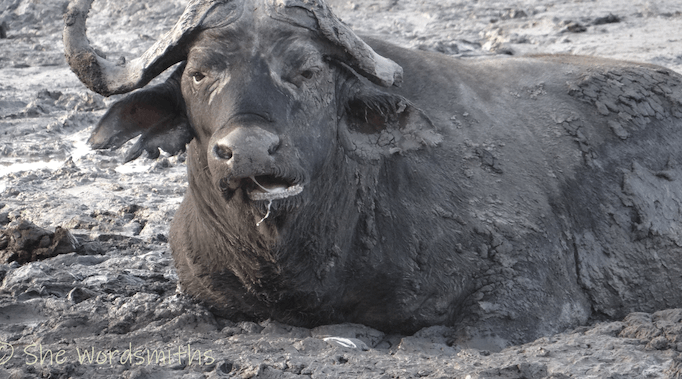 We would see so many different displays. From the grumpy mother who was determined not to let our hosts get back to camp in time for tea. To the baby who couldn't lift itself out of the ditch it had been drinking from, needing two of the adults to offer a helping hand – or rather trunk. There were more elephant family moments than you could count. Ruaha had truly stamped it’s imprint on my heart.
By comparison the Selous elephants are much more cautious. They have learnt not to trust humans and so a fleeting view is as much a privilege.
As we left this beautiful country we reflected on all that we had witnessed. The highs and the lows which the climate had showed us. The word was that “proper” rain could reach some parts by weekend. Still not the long rains, but even a few days would spark some growth and provide much needed water in areas. And that would mean the game didn't have to travel so far while weak.
Let it rain!
Author and images: Marie T Smith who blogs as www.shewordsmiths.com and also at www.onemillionbootsteps.co.uk
We would see so many different displays. From the grumpy mother who was determined not to let our hosts get back to camp in time for tea. To the baby who couldn't lift itself out of the ditch it had been drinking from, needing two of the adults to offer a helping hand – or rather trunk. There were more elephant family moments than you could count. Ruaha had truly stamped it’s imprint on my heart.
By comparison the Selous elephants are much more cautious. They have learnt not to trust humans and so a fleeting view is as much a privilege.
As we left this beautiful country we reflected on all that we had witnessed. The highs and the lows which the climate had showed us. The word was that “proper” rain could reach some parts by weekend. Still not the long rains, but even a few days would spark some growth and provide much needed water in areas. And that would mean the game didn't have to travel so far while weak.
Let it rain!
Author and images: Marie T Smith who blogs as www.shewordsmiths.com and also at www.onemillionbootsteps.co.uk
 We would see so many different displays. From the grumpy mother who was determined not to let our hosts get back to camp in time for tea. To the baby who couldn't lift itself out of the ditch it had been drinking from, needing two of the adults to offer a helping hand – or rather trunk. There were more elephant family moments than you could count. Ruaha had truly stamped it’s imprint on my heart.
By comparison the Selous elephants are much more cautious. They have learnt not to trust humans and so a fleeting view is as much a privilege.
As we left this beautiful country we reflected on all that we had witnessed. The highs and the lows which the climate had showed us. The word was that “proper” rain could reach some parts by weekend. Still not the long rains, but even a few days would spark some growth and provide much needed water in areas. And that would mean the game didn't have to travel so far while weak.
Let it rain!
Author and images: Marie T Smith who blogs as www.shewordsmiths.com and also at www.onemillionbootsteps.co.uk
We would see so many different displays. From the grumpy mother who was determined not to let our hosts get back to camp in time for tea. To the baby who couldn't lift itself out of the ditch it had been drinking from, needing two of the adults to offer a helping hand – or rather trunk. There were more elephant family moments than you could count. Ruaha had truly stamped it’s imprint on my heart.
By comparison the Selous elephants are much more cautious. They have learnt not to trust humans and so a fleeting view is as much a privilege.
As we left this beautiful country we reflected on all that we had witnessed. The highs and the lows which the climate had showed us. The word was that “proper” rain could reach some parts by weekend. Still not the long rains, but even a few days would spark some growth and provide much needed water in areas. And that would mean the game didn't have to travel so far while weak.
Let it rain!
Author and images: Marie T Smith who blogs as www.shewordsmiths.com and also at www.onemillionbootsteps.co.uk




